 | E-mail to Birds Korea |
 | KWBS |
in the Region
 | The Oriental Bird Club |
 | BirdLife International (Asia) |
Written and compiled by Tim Edelsten and Nial Moores, with additional editing and layout by Charlie Moores and substantial contributions by Shim Kyu-Sik.
Out of the 400 or so species recorded in total during 2008 in the Republic of Korea (ROK), this review contains especially notable records of 158 species. These records were submitted to Birds Korea by members or visiting birders, and have been gleaned from key literature and a dozen other domestic birding websites.
Identification of the review species has in almost all cases been made by the observer(s) themselves, and is usually supported by photographs, as clarified in the text. In the absence of a national records committee, details of several of the records were respectfully requested from observers (and in the absence of a response or necessary online supporting details, have occasionally been omitted), while many of the more notable records have also already been open to public review, through online-posting by Birds Korea or by other websites. In the case of a few very difficult identifications, images or descriptions have also been assessed by independent identification specialists.
Following this process, 2008 produced three new additions to Category One of the Birds Korea Checklist: Lesser Black-backed Gull Larus fuscus, Roseate Tern Sterna dougallii and Desert Wheatear Oenanthe deserti. In addition, Ortolan Bunting Emberiza hortulana was elevated to Category One from Category Three. One regularly-occurring species, Grey-capped Pygmy Woodpecker Dendrocopos canicapillus was recorded breeding for the first time in the ROK and due to taxonomic changes, Taiga Bean Goose Anser fabalis, was also reviewed for the first time in 2008. A further 20 or so species are included in the review as they have likely been recorded less than ten times previously. Some of these species are likely very rare in Korea, while an unmeasurable proportion will simply have been overlooked in previous years.
While incomplete, the Birds Korea Year Reviews remain the only annual review (in either English or Korean) of the majority of ornithologically significant records collected nationally. This important process is only possible due to the generous efforts of all who submit or help to assess images and records: sincerest thanks to all concerned, most especially to Dr. Shim Kyu-Sik. This year our records are drawn from the following 125 observers (arranged alphabetically, with family name provided first for those of East Asian origin, and given names first for those from other regions):
A
Adam Timpf (AT)
Adrian Boyle (AB)
Adrian Riegen (AR)
Andreas Kim (AK)
Angela Nebel (AN)
Aurelien Audevard (AA)
Avifauna Sweden (AVF)
(Comprising Anders Blomdahl, Lars Ceder, Soren Strandberg, Inger Christiansson, Morgan Hangren, Per-Ole Syvertsen, Ann Charlotte Strand, Goran Hansson, and Nial Moores)
B
Bae Sang-Woo (BSW)
Barry Heinrich (BH)
Bek Han-Ki (BHK)
Brian Beers (BB)
C
Chai Seung-Hoon (CSH)
Cho Heung-Sang (CHS)
Cho Seung-Ho (CSHO)
Choi Bek-Soon (CBS)
Choi Jang-Young (CJY)
Choi Soon-Kyu (CSK)
Choi Tae-Heon (CTH)
Chris Hassel (CH)
D
Dominique Tavenon (DT)
E
Emily Styles (ES)
F
Fred Van Gessel (FVG)
G
Geoff Styles (GS)
Goh Kyoung-Nam (GKN)
H
Hayley Wood (HW)
Hee-Sun Newlin (HSN)
Huang Jae-Heung (HJH)
Hong Gil-Pyo (HGP)
I
Im Bek-Ho (IBH)
Inge Thaulow (IT)
J
Jan Van de Kam (JVDK)
Jang Yong-Chang (JYC)
Jake McLennan (JM)
Jeong Da-Mi (JDM)
“Jean-Francois” (JF)
Jeff Hopkins (JH)
Jeon Shi-Jin (JSJ)
Jeong Jae-Eum (JJE)
Jeong Jin-Mun (JJM)
Ji Nam-Joon (JNJ)
Jin Seon-Dok (JSD)
Jo Seong-Sik (JSS)
Joan Holt (JOH)
Joh Sam-Rae (JSR)
John Roberts (JR)
Joseph Bieksza (JB)
Ju Yung-Ki (JYK)
K
Kang Chang-Wan (KCW)
Kang Hee-Man (KHM)
Kang Young-Ho (KAYH)
Kim Dae-Hwan (KDH)
Kim Dong Hyun (KDHY)
Kim Dong-Won (KDW)
Kim Eun-Mi (KEM)
Kim Gwang-Hwan (KGH)
Kim Gye-Soo (KGS)
Kim Gyon-Ho (KGHO)
Kim Hyang-Ee (KHE)
Kim Hyo-Gun (KHG)
Kim Hyun-Tae (KHT)
Kim Hwa-Yeon (KHY)
Kim Jun-Cheol (KJC)
Kim Nam-Song (KNS)
Kim Shin-Hwan (KSH)
Kim Sona (KS)
Kim Seok Min (KSOM)
Kim Seok-Yee (KSY)
Kim Song-Mi (KSM)
Kim Su-Kyoung (KSK)
Kim Tae Kyun (KTK)
Kim Woo-Soo (KWS)
Kim Young-Ho (KYH)
Kwak Ho Kyoung (KHK)
Kwang Chan-Soo (KCS)
L
Lee Hae-Soon (LHS)
Lee Heung-Sang (LHSA)
Lee Gi-Soo (LGS)
Lee Jae-Heung (LJH)
Lee Jong-Min (LJM)
Lee Kwang-Goo (LKG)
Lee Sang-Il (LSI)
Lee Sang-Mu (LSM)
Lee Song-Won (LSW)
Lim Wi-Gyu (LWG)
Lee Woo-Man
Lee Yu-Man (LYM)
Lee Yang-Sop (LYS)
Lim Young-Sup (LYUS)
M
Margaret Cameron (MCA)
Martin Fichtler (MF)
Min Ji-Hong (MJH)
Matthew Poll (MP)
Michael Poulsen (MPO)
Martin Sutherland (MS)
Mark Wilkie (MW)
N
Nial Moores (NM)
P
Paul Newlin (PAN)
Park Byoung-Woo (PBW)
Park Chon-Sok (PCS)
Park Eun-Nam (PEN)
Park Heung-Sik (PHS)
Park Hyun-Woo (PHW)
Park Jong-Gil (PJG)
Park Joo-Hyun (PJH)
Park Joo-Young (PJY)
Park Ji-Hwan (PJIH)
Park Jin-Young (PJIY)
Park Keon-Seok (PKS)
Park Geun-Sik (PGS)
Park Min-Jol (PMJ)
Peter Nebel (PN)
Park Cheol-Woo (PCW)
R
Richard Chandler (RC)
Randy Horvarth (RH)
Richard Loyn (RIL)
Richard Lindie (RL)
Rob Macfie (RMF)
Robin Newlin (RN)
S
Scott Holt (SH)
Serge Nicolle (SN)
Song In-Sik (SIS)
Shin Jae-Suk (SJS)
Shim Kyu-Sik (SKS)
Sten Asbirk (SA)
Suh Han-Soo (SHS)
Suh Jung-Ki (SJK)
T
Team Bavaria (TBV)
(Comprised of Heiko Kratezel, Kirsten Kraetzel, Soenke Tautz, Jörg Langenberg, Thomas Langenberg, Johanna Rathberger-Khan, Armin Schneider and Nial Moores)
Team Norway (TNOR)
(Comprised of Kjetil Schjølberg, Bjorn Olau Tveit, Eirik Gronningseter, Bjorn Fuldseth and Espen Lie Dahl and Nial Moores)
Tim Appleton (TA)
Tim Edelsten (TE)
“Thomas G” (TG)
V
Victor Stanger (VS)
Y
Yang Hyun Sook (YHS)
Yim Bek-Ho (YBH)
Yu Dae-Ho (YDH
Yu Dong-Seok (YDS)
Yu Sung-Ho (YSH)
Yu Kwan-Hee (YKH)
Some Main Sites Mentioned in Text
| Site Name | Area | Approximate Location |
| Socheong Island | Ongjin County, Incheon | 37° 45' N 124° 44' E |
| Song Do | Incheon | 37° 25' N 126º 39' E |
| Namyang Bay/Hwaseong | Gyeonggi Province | 37° 10' N 126° 48' E |
| Seosan Reclamation Area, “Seosan” | Chuncheongnam Province | 36° 37' N 126° 25' E |
| Weiyeon Island | Chuncheongnam Province | 36° 13' N 126° 05' E |
| Eocheong Island | Gunsan, Jeollabuk Province | 36° 07' N 125° 58' E |
| Geum Estuary | Chungcheongam & Jeollabuk Province | 36° 01' N 126° 35' E |
| Saemangeum Estuarine System | Jeollabuk Province | 35° 50' N 126° 45' E |
| Heuksan Island | Shinan County, Jeollanam Province | 34° 41' N 125° 28' E |
| Hong Island | Shinan County, Jeollanam Province | 34° 40' N 125° 10' E |
Acronyms
BDB: Birds Data Base website, at: http://birddb.com
BIJ: Birds in Jeju website, at: http://www.birdsinjeju.com
JWRC: Jeju Wildlife Research Center.
KWBS: Korean Wild Bird Society website at http://www.kwbs.or.kr
MOE Census (2008): 2008 Winter Bird Census, published by the Ministry of Environment, collating counts at approximately 141 sites nationwide between January 25th and 27th.
NPMBC (2008): Annual Report on Migratory Bird Research on Hong Island and Heuksan Island, Shinan County, published by the Korea National Park, National Park Migratory Bird Research Center. Website at http://www.npmbc.or.kr
SSMP: Saemangeum Shorebird Monitoring Program, conducted by Birds and the Australasian Wader Studies Group
WIK: Wild in Korea website at http://www.wildinkorea.com
Selected Species Accounts
Order, nomenclature and status codes, follow the Birds Korea Checklist (Moores & Park 2009): http://birdskorea.org/Birds/Checklist/BK-CL-Checklist-Aug-2009.shtml. For seldom-recorded species V2 = <10 records before 2008, and V1=>10 records in total by 2008 and <10 records annually by 2008. Global Conservation Status (CR = Critically Endangered, EN= Endangered, VU=Vulnerable, NT= Near Threatened) is from BirdLife International (2011).
Species covered in the review include: those of global and regional conservation concern; species considered to have been recorded in the ROK less than ten times previously in total; those recorded in exceptional concentrations or locations; those species recorded on unusual dates in 2008 (including attempted breeding or over-wintering); and those species whose status in the ROK remains rather unclear.
Swan Goose Anser cygnoides  P3,W4
P3,W4
A local migrant and scarce winter visitor. The regular presence of birds with blue neck bands suggests that most individuals migrate here from the Lower Amur/Dauria region (EAAF 2011). At the Han-Imjin Estuary (where most regular and numerous), 300 were present on October 14th, with 100 seen on the 22nd of that month (TNOR). Nearby at Paju, blue neck-banded individual "R2E" was photographed on November 8th (PHS). In the Nakdong Estuary, Busan, two were found on February 19th (AVF). Later at the Geum Estuary, 20 were noted on April 1st (ES, GS), including the blue neck-banded "RO5", spending its second successive winter there. Also at the Geum, 70 had returned by November 5th (NM, MPO, MF, SA, IT, TG). On December 31st, five were seen at the Geum River barrage (TBV).
Taiga Bean Goose Anser fabalis P2, W3
Formerly considered a subspecies within Bean Goose A. fabalis (sensu lato). Recently given specific status and reviewed here for the first time. Although much less numerous than Tundra Bean (latter with c. 50,000+ now over-wintering annually: MOE Census 2008), Taiga Bean is a locally common migrant and winter visitor with an estimated minimum 6,000 wintering in the ROK in 2000. See: http://www.birdskorea.org/Birds/Miscellaneous/BK-BM-Eastern-Taiga-Bean-Goose.shtml.
Greater White-fronted Goose Anser albifrons P1, W2
An abundant passage migrant and increasingly numerous winter visitor (with >103,000 recorded by the MOE Census 2008). One neck-banded individual (white, with "H42" in black) that was photographed at Cheorwon on November 30th (RN, SKS) will likely have been a locally rehabilitated and marked bird (EAAF 2011).
Lesser White-fronted Goose Anser erythropus  P/W5
P/W5
A scarce migrant, most regular in October/November and again in March, and a fairly rare but generally overlooked winter visitor. In January, one probable at Daeho (Chungcheongnam Province) on the 5th (NM, KSK) was followed by another reported near Seongsan Ri, Jeju, on the 19th (JH, KEM, KCW). A First-winter (presumably the same bird) was then at Hado Ri on Jeju Island on February 20th and 21st (AVF), and again on the 24th (BH). At Seosan Reclamation Area, one was present on October 8th (LWM) and two were photographed on November 2nd (SKS). At Geocheonnam Lake, Haenam, seven (four adults and three First-winters) were found on December 28th, with one seen there the following day (TBV).
Snow Goose Chen caerulescens WV1
An estimated 20-30 are believed to winter in East Asia annually (Wetlands International, 2006). A rare winter visitor, with probably between three and five individuals in the ROK most years (and only two listed in MOE Census 2008). A flock of twelve (plus one hybrid-type), present on Ganghwa Island (Incheon) since November 2007, was photographed again on January 13th (PHS). The largest previous published record is of 15, also near Incheon, in February 1948 (Wolfe 1950). Elsewhere, one at Wangsong Reservoir, Uiwang, Seoul was present from February 4th to at least February 12th (KHK). In the latter part of the year, two were seen on November 2nd (TE, RN, SKS) and one was photographed on November 17th (KSH) in the Seosan Reclamation Area. In addition, two hybrids were present at Seosan on February 20th, with another, presumed-different hybrid also photographed there on December 1st (KSH).
Cackling Goose Branta hutchinsii WV1
First recorded in 1992 (Park, 2002), this species has been recorded annually or near-annually in recent years. In 2008, one was at Seosan on October 15th (TNOR), becoming approximately the 11th record (involving c. 26 individuals).
Mute Swan Cygnus olor W5
A rare and perhaps irregular winter visitor, with an estimated population of between only 1000 and 3000 individuals in East Asia (Wetlands International 2006). There have been few, if any, documented records since 2005 (with none recorded by the MOE Census in either 2006 or 2007). There were several records in 2008. At Hwajinpo, Gangwon Province, six (two adults and four immatures) were photographed on January 8th (PHS), staying for up to one week. On Jeju Island, four adults were photographed on June 17th (KHM) and remained until September (Kang et al. 2010) (this is the first summer record, and might plausibly include birds from the increasing feral population in Japan). In October, one Second Calendar-year was at Paldang, Seoul (via SKS), followed by another photographed at Seosan on October 27th (KSH).
Falcated Duck Anas falcata  W3, SV2 Br: 3
W3, SV2 Br: 3
A locally common winter visitor, with highest mid-winter concentrations typically found at the Nakdong Estuary, Busan. A total of 4155 were recorded by the MOE Census (2008).
American Wigeon Anas americana V1
First documented record in 1993 (Park 2002), with few subsequent records. Probably annual in very small numbers, but status confused by comparatively numerous hybrids. One recorded by the MOE Census (2008) was followed by a male photographed on April 6th at Gyehwado, Saemangeum (SSMP): the latter a rather late and unusual record (as away from the south coast). At the more typical location of the Nakdong Estuary, Busan, two were photographed on November 30th (KHY), with at least one there still on December 14th (KHY).
Mallard Anas platyrhynchos W1, S4
On June 1st, a female with ducklings was seen, but not photographed, on the Anyang Stream in southwest Seoul (TE). There are perhaps no fully-documented breeding records of wild Mallard in the ROK.
Baikal Teal Anas formosa  W1, SV2
W1, SV2
At present the ROK’s most numerous wintering duck, with individuals occasionally over-summering. A flock of at least 690,000 at Gocheonam, Haenam on January 7th (NM, KSK) is probably the largest national count to date. This count exceeded both the global population estimate given in Wetlands International (2006), and also the total recorded during the MOE Census 2008 (626,610). In the second half of the year, 70,000 had returned to the Seosan Reclamation Area by October 14th (TNOR), with an estimated 200,000 at the Mangyeung Estuary (Saemangeum) on October 30th and 31st (JVDK). At least 130,000 were also at the Geum River on November 5th (NM, MPO, MF, SA, IT, TG), and 250,000 were at Yeongam Lake, Haenam, on December 29th (TBV).
Green-winged Teal Anas carolinensis V2
Only one previous ROK record (in January 1979). A male photographed at Sangju, Gyeongsangbuk Province on February 23rd (PHW), and again on the 24th (JSS), was followed by a second male photographed at Incheon on March 11th (BDB). On Eocheong Island, a probable female was also present on April 2nd and 3rd (NM).
Baer's Pochard Aythya baeri  V1
V1
One of Asia's most threatened Anatidae, having undergone an alarming decline in recent years. Two males photographed at Junam Reservoir, Gyeonsgangnam Province, on February 18th (AVF) were still present the following day (TE). None were reported by the MOE Census in 2008.
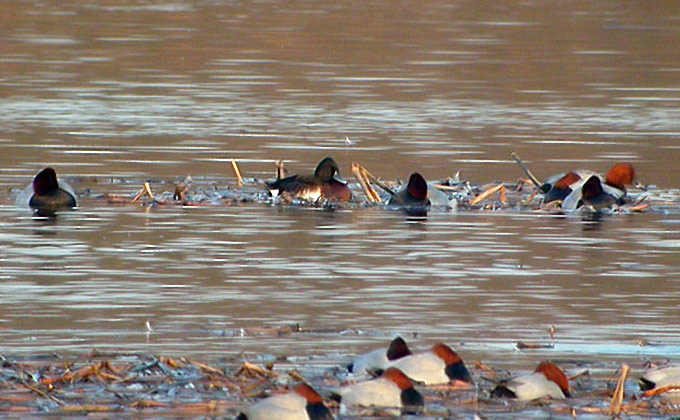
Ferruginous Duck Aythya nyroca  V1
V1
One photographed at Paldang (east of Seoul) on January 29th (KHK, KDW) was still present on February 6th (TE). This was followed by another at Seongsan Lake, Gunsan, from February 10th-24th (JM, PN): c. 6th national record. In addition, a presumed Ferruginous Duck x Common Pochard hybrid was photographed on January 5th (YHS) at an undisclosed location. Another hybrid (perhaps Ferruginous Duck x Greater Scaup) was at Sokcho, Gangwon Province, on January 6th (PHS).

Long-tailed Duck Clangula hyemalis V1
A rare winter visitor, apparently most regular along the northeast coast. Fewer than ten records are cited in Park (2002), and there were only six records known to Birds Korea between 2002 and 2006 (when last recorded). In 2008, two at Hwajinpo, Gangwon Province, on February 14th (AVF) were followed by one probable female far offshore from Daejin, Gangwon Province on March 9th (NM). A female and a male were photographed at Hwajinpo on March 14th (PJH, YHS). On November 25th a male was seen on Hwaseong Reclamation Lake (PEN) in Gyeonggi Province, the first fully-documented record from the west coast known to Birds Korea. This was followed by the same or another male sighted on nearby Shiwha Lake, Ansan, on December 30th (SIS).
Scaly-sided Merganser Mergus squamatus  W5 Br: NN2
W5 Br: NN2
The global population has been estimated at only 1,000-2500 individuals, and declining (Wetlands International, 2006) though recent estimates suggest a population of 1700 pairs (WWT 2011). This is a typically very wary winter visitor favouring broad (50-100m wide), shallow rivers with areas of faster-flowing, open water. Probably between 20 and 50 overwinter most years in the ROK (Moores 2002). In 2008, reported from at least five locations:
- ‘North East River’, Gangwon Province: Numbers along this stretch of river apparently peaked on January 15th, when twelve were photographed (KSH). Lesser numbers were seen through the winter until March 4th at least, when a male with a deformed bill (first recorded in January 2005) was photographed (BDB). In the latter half of the year, three had returned by December 15th (KGS), with between eight and twelve present on December 16th (PBW). By December 29th, the male with the deformed bill had returned to this site for its fifth successive winter (JJM).
- Ten were photographed on November 30th on Jisok Stream, Hwasun County, Jeollanam Province (PCS).
- Six were recorded close to the SE River by the MOE Census (2008).
- A male and female were photographed on November 9th (BDB) at Hwajinpo, Gangwon Province.
- One was present at sea close to Heuksan Island, Shinan County, in December 2007 and again in February-March 2008 (NPMBC 2008).
Yellow-billed Loon Gavia adamsii  W5
W5
Globally scarce with a world population estimated at between 16,000 and 32,000, and an increasingly recorded, though uncommon, winter visitor to the ROK (probably more common formerly). Now known to overwinter regularly in the West Sea (Birds Korea 2010). One was photographed off Daejin, Gangwon Province, on March 9th (SKS) and one was seen from Igidae, Busan on March 17th (NM). Remarkably, one was photographed at Hado Ri, Jeju in July (Kang et al. 2010), becoming the first mid-summer record (all other records known to Birds Korea have fallen between December and May).
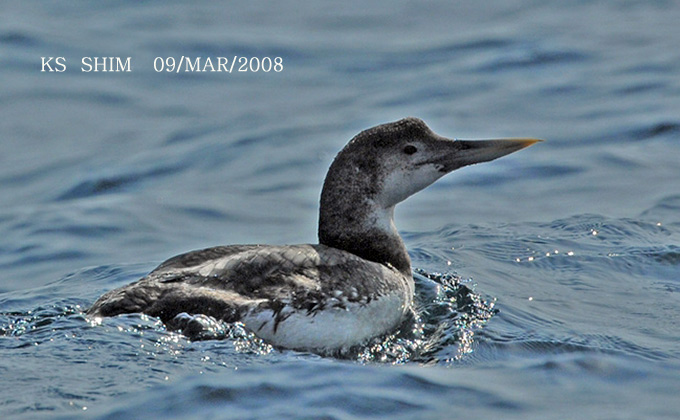
Short-tailed Shearwater Puffinus tenuirostris P5
One seen off Mara Island, Jeju, in May (Kang et al. 2010) appears to be the only record for 2008 (as there is very poor coverage of open sea areas this species’ status remains very poorly-known).
Flesh-footed Shearwater Puffinus carneipes P5
An apparently generally scarce migrant, most frequent in autumn (however, as there is very poor coverage of open sea areas this species’ status still remains poorly-known). Two were seen between Incheon and Socheong Island on October 2nd, with a further two in the same area again on October 5th (SKS). Three were seen from the ferry between Gunsan and Eocheong Island on October 16th, with five seen close to the island on the 17th. Two were again seen from the return ferry to Gunsan on the 18th of that month (TNOR).

Great Crested Grebe Podiceps cristatus cristatus W3, R5 Br: 1
A pair was photographed on the nest at Namyangju, near Seoul, on May 2nd, and with at least one chick on May 10th (CSH). At Uiwang Reservoir, Seoul, September 7th, three pairs had managed to raise at least four young between them (TE). There are few known breeding sites in the ROK. Recent fully-documented breeding records come from e.g. Yangpyong in 2006 (YHS), Shihwa Reclamation Lake in 2006 (BDB) and Seosan in 2007 (KSH).
Black Stork Ciconia nigra P5, WV1 Br: 3
Two were reported at the now traditional wintering site at Hampyeong County, Jeollanam Province by the Kyunghang Shinmun (February 1st).
Oriental Stork Ciconia boyciana  W5, SV2 Br:3
W5, SV2 Br:3
Formerly bred, but at present a rare and localised winter visitor (October to March), typically requiring extensive and relatively undisturbed shallow wetland. Twenty were reported between January 25th and 27th by the MOE Census (2008), and the species was recorded from at least seven locations in total during the year:
- Eleven were present at Gomso Bay, Jeollabuk Province, in late January (MOE Census 2008) until at least February 16th (KSK).
- At the Seosan Reclamation Lakes five were present on January 6th (NM, KHT, KSK) with six there on February 14th (AVF). In the latter part of the year, three had returned by November 5th (SHS), increasing to five by December 25th (TE, SKS, PHS).
- Two, then one, were photographed in the Hwaseong Reclamation Area in early-mid November (SIS).
- One or two were present from November 22nd (HDG) until at least December 28th (TBV) in Goheung Bay, Jeollanam Province.
- On Jeju Island, one present near Geumdong Ri since October 2007 was seen regularly through the winter until at least March 18th (KHM).
- One was reported at Yeongam Lake, Jeollanam Province (MOE Census 2008).
- One seen in flight over Song Do, Incheon, on October 19th (SKS) is the first record for this site.

Yellow Bittern Ixobrychus sinensis S3 Br: 1
A widespread breeding summer visitor, locally common in suitable habitat. One male photographed at Seosan on December 13th (KSH) is apparently the ROK’s first winter record.
Cinammon Bittern Ixobrychus cinnamomeus V1
In 2008, one was present on Heuksan Island, Shinan County, in May and June and one or two were recorded on Hong Island, Shinan County, in May, including one banded on the latter island on May 14th (NPMBC 2008); one was seen on Mara Island, Jeju, on June 6th (JWRC), followed by another photographed at Seongsan, Jeju Island in July (JES). There have now been at least ten records of this species, almost all between May and July (with the exception of one December record from Jeju reported in Kang et al. 2010).
Black Bittern Dupetor flavicollis V1
A rare spring migrant to the west and southwest, with extreme dates of April 21st and “June”. The species was recorded first in 1990 and then annually since 2003, with approximately 12 records by the end of 2007. In 2008 one was photographed at Seocheon, Chungcheongnam Province in May (Kang et al. 2010), and another that was photographed on Heuksan Island, Shinan Gun, on May 30th (PJG) remained into June (NPMBC 2008).
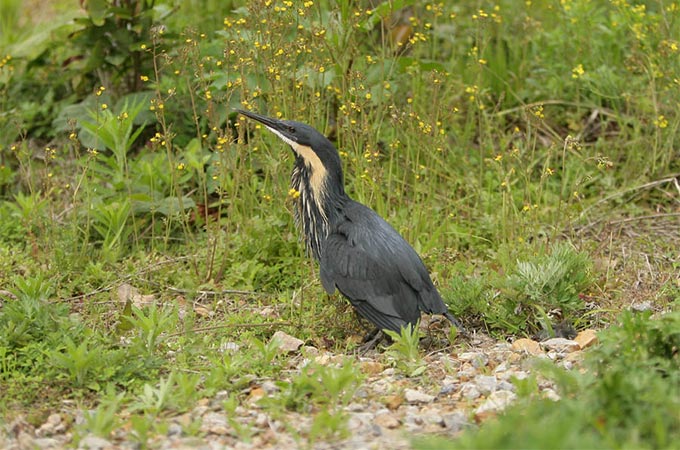
Japanese Night Heron Gorsachius goisagi  V1
V1
A rare migrant through the ROK, mostly recorded in April and May. In 2008, one adult photographed near Buan, Jeollabuk Province, on May 4th was present until at least May 9th (SSMP). Another was photographed on Jeju Island on May 6th (KYH), and a pair was seen near Seogwipo, Jeju, in July (Kang et al. 2010). A Gorsachius Night Heron found on Socheong Island, Ongjin County, on May 12th (RN), and still present on May 18th (NM), was likely a Second Calendar-year Japanese Night Heron, but based on the bird’s blackish crown and pale-tipped primaries Malayan Night Heron G. melanolophus cannot perhaps be fully ruled out.
Striated Heron Butorides striata
One was photographed at Hado Ri, Jeju Island in December (Kang et al. 2010), becoming perhaps the first fully documented mid-winter record.
Pacific Reef Heron Egretta sacra R4 Br: 1
An uncommon and local breeding resident which is most regular in the southwest, occasionally recorded as far east as Busan and as far north as Eocheong Island. One seen on Socheong Island, Ongjin County, on May 16th (NM, JOH, SH), is a first record for this island, and the most northerly record of this species in the ROK. Tomek (1999) lists five records from the DPRK, all from the west coast.
Chinese Egret Egretta eulophotes  S4, WV2 Br: 1
S4, WV2 Br: 1
A scarce summer breeder on remote islands in the Yellow Sea, typically arriving on mainland coastal tidal-flats in early April and departing by mid-October. Notable records in 2008 included two banded individuals at Song Do, Incheon. The first (Right tibia: blue over yellow) on August 3rd, and the second (blue over yellow over red) on August 15th (TE). The banding location of these birds has not yet been confirmed. One at the Geum Estuary on November 5th (NM, MPO, MF, SA, IT, TG) is rather late.

Lesser Frigatebird Fregata ariel V1
A scarce but increasingly reported species. There were two records in 2008. A juvenile was photographed over the Seosan Reclamation Area on May 6th (NM, AR), and another (age unknown) was photographed on Mara Island, Jeju, on August 20th (KCW). The latter becomes approximately the 13th national record known to Birds Korea.
White-tailed Eagle Haliaeetus albicilla W4, RV1 Br: 1
An immature seen on the Gwonganjin River near Paldang in May (JR, VS) is a notably late mainland record.
Steller's Sea Eagle Haliaeetus pelagicus  W5
W5
A regular winter visitor to a few traditional sites, with probably 10-15 present nationwide most years. In 2008 recorded from at least five locations:
- One adult and one Third Calendar-year were present through the winter on the Han River near Paldang, Seoul until at least February 13th (AVF). In the latter half of the year an adult was present there from December 7th onwards (JB).
- Two or three, including one adult, were seen in the Nakdong Estuary, Busan, on February 19th (AVF).
- One was present at Yangyang, Gangwon Province, in late January (MOE Census 2008) until at least February 16th (RN, HSN, PN, AN).
- One was seen on February 16th at Gangneung, Gangwon Province (RN, HSN, PN, AN).
- One sub-adult was photographed regularly from February 16th (LYSU) until at least March 8th (LSW) on the Geum River, Yonggi-Gun, Chungcheongnam Province.
Cinereous Vulture Aegypius monachus  W3, RV1
W3, RV1
Approximately 1000-1200 have over-wintered in recent years (e.g. Lee et al. 2004). In 2008, at least eight birds with individually-numbered wing-tags (placed on birds in Mongolia) were reported:
- No. 31: Munsan, Gyeonggi Province, on January 2nd (LJH).
- No. 21: Hong Island (Shinan County?) on January 15th (MJH).
- No. 70: Cheorwon, Gangwon Province, December 19th(LSI).
- No. 56: Undisclosed location, December (CBS).
- No. G5: Undisclosed location December 24th (SJK).
- No. H5: Undisclosed location, December 24th (SJK).
- No. G1: Undisclosed location, December 24th (SJK).
- No. 61: Paju, Seoul, December 25th (LJM).
Northern Harrier Circus cyaneus W4 Br: NN
An uncommon and scarce winter visitor. The highest count was a roost of >35 at Geocheonam Lake, Haenam, on December 29th (TBV).
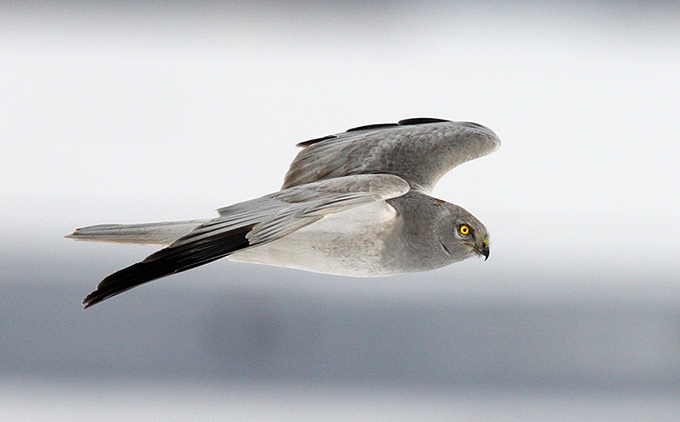
Northern Goshawk Accipiter gentilis P/W3, R5 Br: 1
A pair with one chick was photographed at the nest at an unidentified location in Chungcheongnam Province on May 29th (LSW). This is only the second recent breeding record, after the first in 2006. The species is believed to have been a regular breeding species >100 years before present (see Duckworth & Moores 2008).
Grey-faced Buzzard Butastur indicus P3, S5 Br: 1
A regular migrant and a scarce breeding species. Breeding was again documented at one or more sites in 2008.
Rough-legged Buzzard Buteo lagopus W5
Typically scarce but rather widespread in the winter of 2007-2008. The highest reported concentration was of nine at Seosan Reclamation Lake A on February 16th (AVF). Perhaps the last record of the season was of one at Paju on March 20th (RN, SKS).
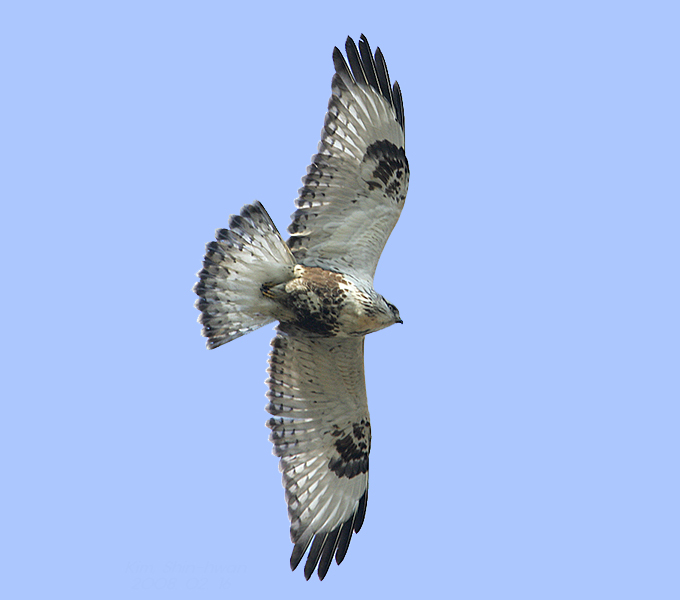
Greater Spotted Eagle Aquila clanga  P/W5
P/W5
In 2008 the only verifiable records known to Birds Korea were on Jeju Island. Three were reported there by MOE Census (2008) with at least one remaining until at least February 26th (MW). In October, one was again observed at Hado Ri (Kang et al. 2010), and was still present on December 19th (BIJ).
Eastern Imperial Eagle Aquila heliaca  V1
V1
A very scarce, local winter visitor and rare migrant. On or around January 1st a juvenile was photographed probably at Cheorwon (LJH). One was at Yeongam Lake on January 7th (NM), remaining there through the winter and recorded by several KWBS members (via SKS). One reported from Hado Ri, Jeju Island in December 2007 (Kang et al. 2010) remained in the area through most of January 2008, being seen or photographed by multiple observers (JH, KEM, KCW). On October 30th a juvenile was photographed at Seosan (SHS).
Steppe Eagle Aquila nipalensis V2
One was recorded on Hong Island, Shinan County, in November (NPMBC 2008).
Golden Eagle Aquila chrysaetos W/P5
Recorded breeding close to Seoul in the first half of the century (Austin 1948), but not subsequently. Recently seen throughout the year on Halla Mountain, Jeju Island (Kang et al. 2010). Otherwise this is a scarce migrant and local winter visitor, with few records annually. In 2008 records came from at least five mainland locations. One was photographed on February 28th in Yeongi County, Chungcheongnam Province (LYUS) with another at Mihocheon, Cheongwon, Chungcheongbuk Province on March 1st (CSK). In the Seosan Reclamation Area, one overwintered until at least February 28th (SHS). Two had returned to this area by November 9th (SKS, KSH), with three recorded there on December 19th (KGH), and two still present until December 30th (KSH). In December, singles were also reported from Yeoncheon and Cheorwon, both in Gangwon Province (via SKS).Saker Falcon Falco cherrug  V1
V1
One seen at Eocheong Island, Gunsan, on April 21st (NM, RN) is a first for the island, and apparently only about the tenth national record.
Swinhoe’s Rail  V2
V2
One was on Hong Island, Shinan County, in November (NPMBC 2008)
White-breasted Waterhen Amaurornis phoenicurus P/S5, WV2 Br: 1
A scarce but increasingly recorded migrant, mostly on southern and western islands in spring. In 2008 a pair was noted in territory in an area of damp grassland in Suwon City during May, and a nest was found (SIS). However, the area was then bulldozed for construction. This pair then relocated to an adjacent area, where they built a new nest and raised 4 chicks. This is the first successful breeding record in the ROK after a previous failed attempt.
Baillon's Crake Porzana pusilla P5 Br: NN2
A scarce and perhaps decreasing migrant. Records in 2008 include an unknown number of individuals on both Hong and Heuksan Islands in May, and again between late August and early November (NPMBC 2008), with three on the latter island on October 19th and 20th (TNOR); and also one well-photographed on Weiyeon Island, Chungcheongnam Province, between September 30th and October 2nd (SHS, LHS). In addition a juvenile at Uiwang reservoir, Seoul, on September 27th (TE) is a scarce mainland record.

Band-bellied Crake Porzana paykullii  V1 Br: NN2
V1 Br: NN2
One was taken into care in Gangseo-gu, Seoul, on May 23rd and photographed (KHK, JJM), and then released several days later at Uiwang Reservoir. There are only c. 12 previous records of this species from the southern provinces of the Korean Peninsula, most recently in May 2007.
Watercock Gallicrex cinerea P/S4 Br: 1
Now a very scarce and local summer visitor, formerly widespread and common. Symptomatic of its continuing decline only three were recorded in June in its traditionally favoured breeding area of the Seosan Reclamation Area despite extensive monitoring of this former stronghold by KWBS members.
Siberian Crane Grus leucogeranus  V2
V2
Data suggest the species tends to migrate around the top of the Yellow Sea, rather than across it: thus there have been only seven records in the ROK between 1992 (the first) and 2004, when last recorded. In 2008, an adult was at Suncheon Bay, Jeollanam Province, from December 12th-14th (via SKS), with a juvenile arriving soonafter on December 16th (HDG) at Goheung Bay, c. 50 km to the southwest. This latter bird was accompanying a small group of White-naped Crane Grus vipio, and was present at least until 21st (KSH), becoming the 9th record for ROK. It is of interest that these two birds arrived in the ROK the same winter as the first Siberian Crane recorded in southwest Japan since 2003, and the first reported at Hangzhou Bay in Zhejiang Province (just south of Shanghai) China in 30 years (Simba Chan in lit. to Oriental Birding List-server, November 2008). It seems likely that a small number of Siberian Cranes were displaced southward down the Korean Peninsula during migration.
Sandhill Crane Grus canadensis V1
An apparently rare migrant which has been recorded annually in recent years and has overwintered once or twice. Three photographed together in Cheorwon, on November 8th (CSHO) were still present on November 30th (via SKS). This is the ninth (and first multiple) record for the ROK.
White-naped Crane Grus vipio  P3/W4
P3/W4
A regular migrant and winter visitor, especially to the Cheorwon area and to the lower Nakdong River. In total, 1433 were recorded nationwide by the MOE Census (2008).
Common Crane Grus grus lilfordi V1
A scarce migrant recorded annually in recent years, most especially in Cheorwon, at the Seosan Reclamation Lakes and in Suncheon Bay, usually accompanying flocks of Hooded Crane Grus monacha. While probably between five and ten individuals have been recorded annually in recent years (with six reported by the MOE Census 2008), the number of records is complicated by the large percentage showing hybrid characters. For example, at Seosan, one photographed on March 13th (CHS) and March 15th (KSH, was accompanied by two hybrids. Also at Seosan, two pure birds and two hybrids were photographed on November 10th (CSHO), with at least one of these pure individuals still present on December 28th (KSH).
Hooded Crane Grus monacha  P3,W4
P3,W4
The world population is estimated at 10,160, with 8700 wintering in Japan (presumably after migrating through the Korean Peninsula), and a much smaller number over-wintering in the ROK itself (Wetlands International, 2006). In 2008, 338 were recorded by the MOE Census (2008). Coordinated monitoring during northward migration by the Birds In Jeju group and the Waterbird Network from March 21st-25th counted c. 4460 Hooded Crane in nine separate flocks, moving northwards through the ROK. This included one flock of 2920 flying over Jeju Island in the afternoon of March 21st (via JYC), perhaps the largest concentration of this species recorded in the ROK to date. During northward migration, flocks were seen to rest and feed at the following sites (in order of timeline): Jeju Island, Suncheon Bay, Cheonsu Bay, Cheorwon, Han-Imjin River Estuary, and Gangwha Island.
Red-crowned Crane Grus japonensis  W4
W4
A total of 784 were recorded by the MOE Census (2008), with almost all close to the DMZ.
Yellow-legged Buttonquail Turnix tanki V1 Br: 2
A scarce and very skulking migrant, most often recorded on offshore islands. In 2008, one was recorded on Heuksan Island in June (NPMBC); one exhausted individual was found on a rooftop in Chungju on October 8th (PGS) and was taken into care; and one was seen on Socheong Island on October 23rd (RN).
Eurasian Oystercatcher Haematopus (ostralegus) osculans W3/R4 Br: 1
A total of 3352 were recorded by the MOE Census (2008). A count of 170 at Namyang Bay on August 30th was noteworthy for this site (TE, RN, SKS).
Black-winged Stilt Himantopus himantopus P/S5, WV2 Br: 1
A widespread and increasingly recorded migrant, with local breeding since at least 1998. In 2008, two at the Namdae Stream, Gangneung, Gangwon Province on December 14th (CTH) remained on site until at least February 2009 (PCW). This is at least the fourth midwinter record known to Birds Korea.
Pied Avocet Recurvirostra avosetta V1
A rare migrant, now recorded annually. At Song Do, Incheon, one on February 7th (RN) was presumably the same individual photographed there frequently since late 2007. It was seen by multiple observers, and last recorded on May 2nd (SSMP). On Jeju Island, two were photographed at Seongsan Po on April 10th and 13th, followed by one on June 14th (JWRC). On Yubu Island in the Geum Estuary, one found on April 6th was still present on April 21st (SSMP). At Hwaseong Reclamation Area, a flock of 12 were photographed on May 5th (SIS) and May 8th (SKS) - the largest concentration in the ROK known to Birds Korea. One was also photographed at Suncheon Bay on December 10th (HDG).

Northern Lapwing Vanellus vanellus W4 Br: NN
An uncommon and local winter visitor, with a non-breeding population estimated at 250 (Moores 2006). A total of 250 were recorded nationwide by the MOE Census (2008) in late January. A count of 104 on tidal-flats below the Geum Barrage on February 3rd (PN) is the largest concentration known to Birds Korea.
Grey-headed Lapwing Vanellus cinereus V1
A very scarce migrant, with several records annually, typically on offshore islands in May. In 2008, one was photographed on Weiyeon Island on May 21st (YDH). Another, photographed near the Nakdong Estuary on June 15th (KHY), is apparently the first summer record. One was also photographed at Oido, Seoul, on October 11th (SIS)
Common Ringed Plover Charadrius hiaticula V1
A rare migrant, perhaps not recorded annually. In 2008 the only record was of one at Mokpo Namhang Wetland, Jeollanam Province, on August 27th (MS, KS, KSY).
Lesser Sand Plover Charadrius mongolus P2/WV1
A locally common migrant, with largest numbers formerly within the Saemangeum Estuarine System. The highest count during northward migration was 4,385 in the Geum Estuary (almost all on Yubu Island) on May 8th (SSMP).
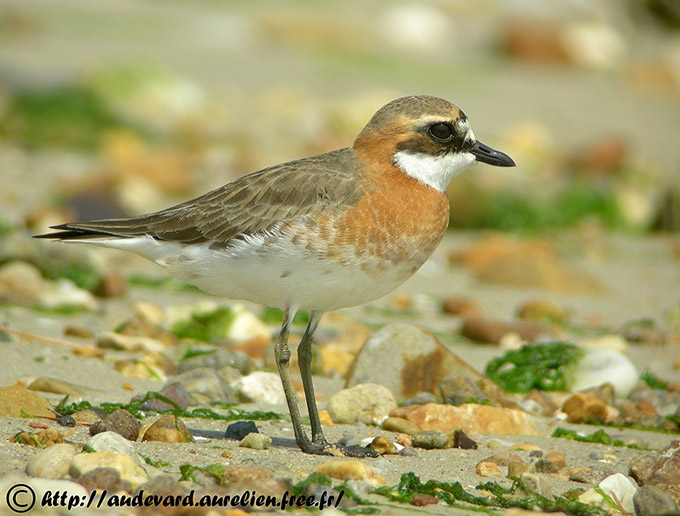
Oriental Plover Charadrius veredus V1
A very scarce migrant, recorded annually in the far southwest in recent years. A flock of eight at Suncheon Bay, Jeollanam Province, on April 5th (RL, HW) is the highest national count known to Birds Korea. Records typically involve single birds in April in the far south, and in 2008, singles were also photographed on April 6th and 12th (KYH) and on April 17th (SKS) on Jeju Island; two were seen on Mara Island, Jeju, on April 11th (JWRC); and at least one was recorded on both Heuksan Island and Hong Island, Shinan County (NPMBC 2008).
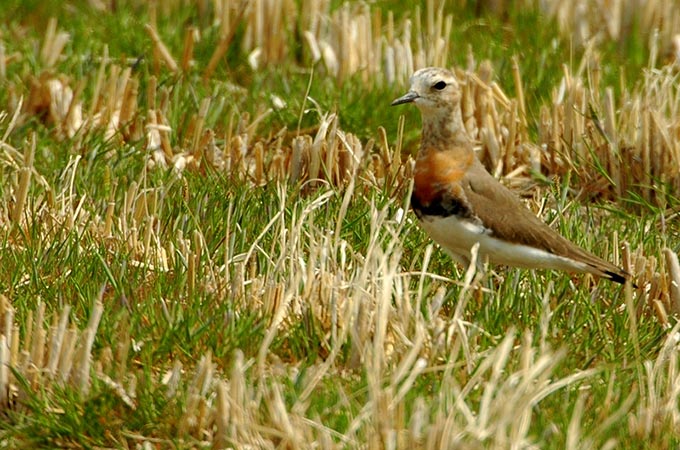
Greater Painted Snipe Rostratula benghalensis S/R5 Br: 1
A shy, scarce and local species, with the first documented breeding record in 2006. Away from the known breeding area of Seosan, breeding was also noted for the second year in succession at Ongpo Ri, Jeju Island. This species has also been observed at Yongsu Reservoir, Dumo Ri, Muleung Ri and Seongsan Eup in recent years (Kang et al. 2010). In addition, an adult and a juvenile were seen at Heungnong, Jeollabuk Province, on August 20th (MS, KS) and a pair and nest were photographed at Shihwa Lake, Ansan, on September 10th (PBW).
Pheasant-tailed Jacana Hydrophasianus chirurgus V1 Br: 1
A juvenile was photographed at Seosan on September 16th (LHS).
Solitary Snipe Gallinago solitaria P/W5
A rare migrant and extremely local winter visitor (November-March) with a non-breeding population estimate of only ten (Moores 2006). Away from the regular wintering site at Gwaneung Arboretum, Seoul, where e.g. four were seen on February 28th (LSI), one was at Seoul Grand Park, Gwacheon in January (SKS), and another was found at Kongreung Stream, Seoul on February 8th (SKS).
Long-billed Dowitcher Limnodromus scolopaceus V1
A very scarce migrant first recorded in 1998 (Moores 1999), and now recorded annually. In 2008, three or four records: one at Mokpo Namhang Urban Wetland on September 5th (KSY) was followed by two probables seen briefly at Song Do, Incheon on September 14th (RN). One first photographed at Hwaseong, Namyang Bay on September 15th (JJM) was then seen by multiple observers and remained on-site until at least September 24th (YHS). At Seosan, one was photographed on October 25th (LKG).
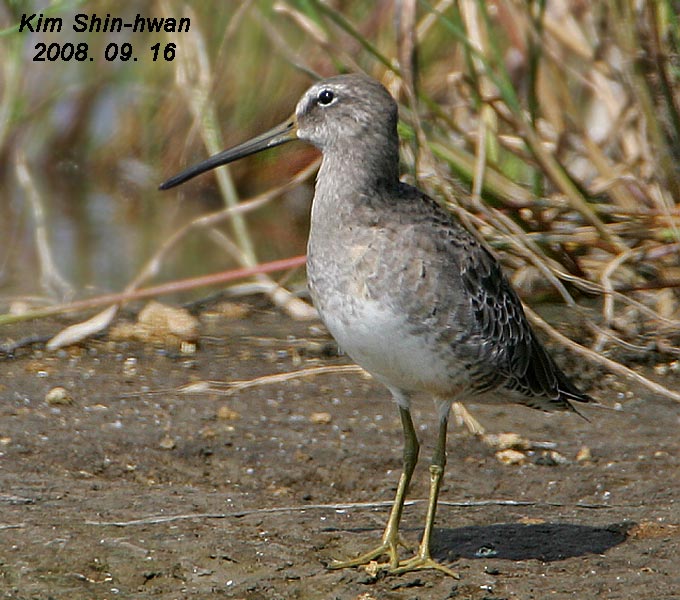
Asiatic Dowitcher Limnodromus semipalmatus  V1
V1
Most recent estimate conservatively puts the global population at 23,000 individuals (Wetlands International, 2006). Scarcely annual in the ROK. Three different individuals were found by the SSMP 2008 in May: one on Yubu Island on May 8th, one at the Dongjin Estuary within the Saemangeum Estuarine System on several dates in May, and one at the Geum Barrage on May 24th.

Black-tailed Godwit Limosa limosa (melanuroides)  P2/WV2
P2/WV2
A locally common but apparently fast-declining passage migrant, found mostly along the west coast northward from Seosan. The melanuroides subspecies’ population is estimated at 160,000 (Wetlands International, 2006). One at Song Do on February 7th (RN) is apparently the first mid-winter record for the ROK known to Birds Korea.
Little Curlew Numenius minutus P5
In April a flock of at least 14 was photographed at Hamo, Jeju Island (JES).Eastern Curlew Numenius madagascariensis  P2, S3, WV1
P2, S3, WV1
Two at Yubu Island, Geum Estuary, on December 31st (TBV) continues the recent run of mid-winter records.
Nordmann's Greenshank Tringa guttifer  P4
P4
Globally Endangered, with an estimated global population of between only 500 and 1000 (Wetlands International, 2006). A scarce and local migrant in the ROK, likely much overlooked as largely confined to extensive intertidal wetlands, with a national estimate of 100 on northward and 150 on southward migration (Moores 2006). The earliest record in 2008 was one photographed at Jocheon Ri, Jeju on April 6th (JWRC). During the SSMP, highest counts by wetland were 56 in the Geum Estuary on May 8th and five within the Saemangeum Reclamation Area between May 8th and 10th (SSMP). Other records during northward migration included a total of 51 along the west and south coasts, with two at Yeongjong Island and 11 at Song Do on May 3rd; 34 at Namyang Bay (including the Kia Tidal-flat) and one at Asan Bay on May 5th; and one at Haenam Hwangsan and two in Suncheon Bay on May 12th (SSMP data). Much less extensive coverage during southward migration resulted in records of one at the Nakdong Estuary on September 7th (KHG), followed by probably four at Yubu Island on September 17th (NM, BB, MS, KS). One was photographed at Namyang Bay on September 18th, with two there on September 28th (JJM), with one seen at the adjacent Kia Tidal-flat on October 14th (TNOR). Finally, eight were counted at Yubu Island, Geum Estuary, on October 15th (TNOR).
Ruddy Turnstone Arenaria interpres P3, WV2
One at Baeksu Tidal flat (Jeollanam Province) on December 30th (TBV) is a rare midwinter record.
Great Knot Calidris tenuirostris  P1/2
P1/2
Within the SSMP Study Region (comprised of the Geum Estuary, Saemangeum and Gomso Bay) the peak count recorded during northward migration was only 23,748, a decline of 80% from the peak of 116,126 recorded in the same area by the SSMP in 2006 (SSMP). At all other internationally important shorebird sites in early to mid-May a further 26,385 Great Knot were recorded, giving a national estimate during northward migration of only c. 50,000 (SSMP, Moores 2011). As a result of the massive decline in the species caused by the Saemangeum reclamation, the species was listed as Vulnerable by BirdLife International in 2009.
Little Stint Calidris minuta V1
A very scarce migrant, first claimed in 1996 (Park, 2002) and with only c. 10 records subsequently. One was photographed on Heuksan Island on April 16th (PJG).
Temminck's Stint Calidris temminckii P5, WV2
An uncommon migrant. One on February 1st in the lower Nakdong River (AT) is the first mid-winter record known to Birds Korea.
Pectoral Sandpiper Calidris melanotos V1
A rare migrant, with usually only one or two records per year. In 2008, there were four records. One was seen at the Dongjin Estuary, Saemangeum on April 6th (SSMP), followed by one at Song Do, Incheon on August 29th (RN). One was photographed at Yonggi-Gun, Chungcheongnam Province on October 4th (CSK), with another also photographed at Ocho Ri, Jeju Island on October 18th (JNJ).
Dunlin Calidris alpina P/W2,SV2
A locally numerous migrant and winter visitor. A total of 150,988 were recorded in early to mid-May at a total of 17 nationally and internationally important intertidal wetlands. This was almost half of all shorebirds (all species) recorded during the same survey effort (SSMP, Moores 2011).
Spoon-billed Sandpiper Eurynorhynchus pygmeus  P5
P5
Fast-declining, with a minimum world population estimate in 2006 of less than 3,000 individuals (Wetlands International, 2006), and of only 120-220 pairs by 2009 (Zöckler & Bunting 2010). A minimum eleven (maximum 15-20) were recorded within the SSMP Study Region during northward migration, with at least eight different birds present in the Geum Estuary in early May, and three different birds present in early and again in late May within the Saemangeum Reclamation Area/Estuarine System (SSMP). Earliest record was of three within Saemangeum on April 28th, and latest record was of four at Yubu Island on May 24th (SSMP). None were found during survey of other internationally and nationally important shorebirds sites along the west and south coasts during in the first half of May (SSMP, Moores 2011). During southward migration, two were photographed at the Nakdong Estuary on September 7th (LGS) and two were again photographed there on September 21st (KHY) (unconfirmed reports suggest that possibly as many as ten birds were recorded there in total, though details are unknown) . At Yubu Island, eight on September 17th included at least three juveniles (NM, BB, KS, MS), with six birds still present there on October 15th (TNOR).
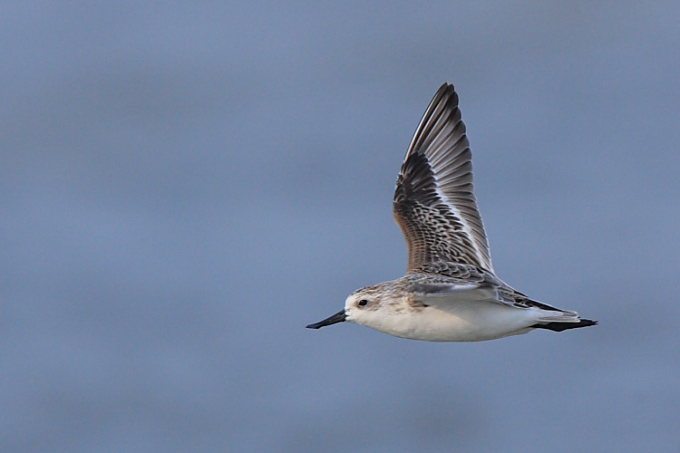
Broad-billed Sandpiper Limicola falcinellus P3
An uncommon migrant. The count of 1130 at Yubu Island on May 24th (SSMP) is the largest count of this species known to Birds Korea during northward migration, making up the vast majority of the 1278 recorded in the SSMP Study Region during the May 20th-24th final high tide count series (SSMP, Moores 2011). The largest previous day count was a remarkably similar 1251, at various sites within the Saemangeum Estuarine System, in October 2007.
Ruff Philomachus pugnax P5, WV2
A scarce migrant. One photographed at Goheung Bay, Jeollanam Province, in January (HDG) is apparently only the second midwinter record known to Birds Korea. Up to 20 at Hwaseong/Namyang Bay on April 26th (SKS) is the largest concentration of this species yet recorded in the ROK.
Oriental Pratincole Glareola maldivarum P/S5 Br: 2
A recently fledged juvenile was photographed near Seosan (HDG) on June 25th. This is the second presumed national breeding record after the first in 2004.
Saunders's Gull Chroicocephalus saundersi  PW3, S4
PW3, S4
A very local breeding species that is rather more widely distributed in winter. Although considered by some to be increasing, especially as a breeder (Kwon 2009), it is more likely that this species is simply becoming better-known. Even so, the species is often overlooked (see Moores 2011, who details much larger numbers being recorded by Birds Korea survey effort at a few sites than during the MOE Census conducted nationwide). In total, only 1252 were recorded by the MOE Census (2008). More than half of these (662) were recorded in Suncheon Bay, with 218 also recorded at the adjacent Yeoja Bay (both sites on the south coast). During survey on the west coast in late December 2008 and early January 2009, between 1526 and 1870 were found at only seven sites, with the largest concentrations at Song Do (392), Cheonsu Bay (273) and Asan Bay (278) (TBV). Breeding was again suspected at Song Do in 2008 (with the “traditional” nesting area now surrounded by construction). At least 200 were present on February 8th and 40 there on April 12th showed territorial and courtship behaviour (TE), while 104 were still in the area on May 3rd (SSMP). On June 22nd, 38 appeared to be gathering food for young, although the status of the presumed breeding colony could not be ascertained (TE). On December 21st, 371 at Song Do comprised c. 15% First-winters (TE). At Namyang Bay two marked Second Calendar-years were photographed on April 5th (SKS):
- Red flag on right tibia, (White lettering "K5" on flag), blue or green band on left tibia.
- Green band on left tibia.
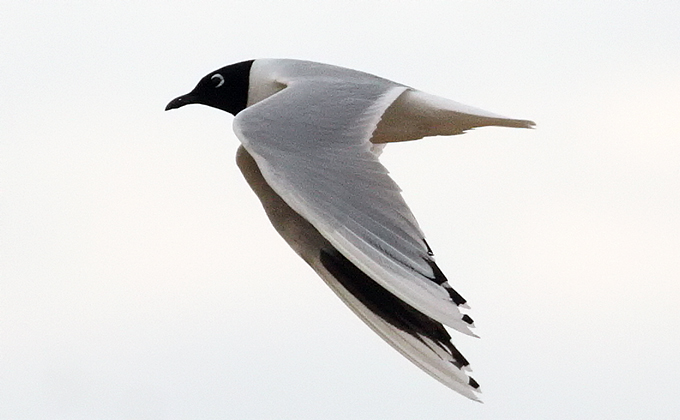
Relict Gull Ichthyaetus relictus  W5
W5
The world population is estimated at 12,000 (Wetlands International, 2006). A scarce winter visitor to ROK, much less numerous in mild winters, and most regular between December and February. One was photographed at Pohang on January 15th (KHK), 20th (KHG) and 26th (BDB). Another was apparently photographed at Haeundae, Busan on January 21st (BDB). At the Nakdong Estuary, nine on February 19th were comprised of eight First-winters and one Second-winter (AVF). Two First-winters were at Song Do, Incheon, on February 22nd (AVF). In the second half of the year two First-winters were photographed in the first week of October at an undisclosed location (perhaps the Nakdong Estuary) (LGS), with a Second-summer type at the Geum River barrage on November 5th (NM, MPO, MF, SA, IT, TG). These are both exceptionally early records.
Pallas's Gull Ichthyaetus ichthyaetus V1
First recorded in December 2002 and annually since, in winter and early spring. In 2008 one (more probably two) was at Goheung Bay, Jeollanam Province on December 28th (TBV), becoming the 12th national record.
Glaucous-winged Gull Larus glaucescens W5
A scarce winter visitor mostly to the east coast. One adult photographed on Jeju Island on April 22nd (JWRC) is a remarkably late date, and unusually far southwest.
Glaucous Gull Larus hyperboreus W4, SV2
First officially recorded only in the 1990s (Park 2002), and subsequently recognized as an uncommon winter visitor, mostly to the east coast. One at Yeongjong Island, Incheon, on May 1st (SSMP) is a rather late date and an unusual record so far northwest.
Mongolian Gull Larus mongolicus P/W3, S4 Br: 1
At least five breeding pairs were found nesting on a small island in a lagoon in Song Do, Incheon on May 3rd (NSS). On May 12th, eight nests were counted, one of which contained two chicks (TE). By June 21st the number of chicks had risen to 13 (TE). This appears to be the first mainland breeding record for this species, although it is already known to nest on several islands off the west coast.
Lesser Black-backed Gull Larus fuscus V2
An adult of the nominate subspecies fuscus (popularly known as "Baltic Gull") was watched in flight, on the ground and swimming in direct comparison with large numbers of gulls (including Larus crassirostris and Larus (heuglini) taimyrensis) on Yubu Island on December 31st (TBV). Very poorly photographed at long-range, this is the first national record, and has been added to Category One of the Birds Korea Checklist.

Gull-billed Tern Gelochelidon nilotica V2
One at Yubu Island on April 6th (SSMP) was followed by another photographed at Hwaseong/Namyang Bay, on May 7th (YDH). At Saemangeum, one was photographed on May 23rd, with the same bird photographed again on May 24th at the Geum Estuary Barrage (almost 30km to the north). In addition, one was also at Yubu Island, Geum Estuary, on the same date: either the same, or possibly a different individual. One was also seen at the Nakdong Estuary, Busan on July 9th (NM, JSJ). There are now at least 12 national records known to Birds Korea.

Caspian Tern Hydroprogne caspia V1
First recorded in 2001 and irregularly since. In 2008 one was photographed at Gangneung City, Gangwon Province, on April 16th (CSK, PJY). Two photographed, also at Gangneung City, on September 24th (PJY) were still present the following day (KHK), becoming about the 12th national record known to Birds Korea.

Roseate Tern Sterna dougalli V2
Two photographed in the Nakdong Estuary, Busan, on June 29th (JSJ, KHE, KHY) were the first record for the ROK. Occurring regularly north to southernmost Japan, this species had been recorded as far north as Kangawa Prefecture, central Honshu, by 1980 (Brazil 1991), and was also recorded several times in the summer months as far north as Fukuoka (northern Kyushu, and only 200 km south of Busan) in the 1990s at least (NM in lit. 2008).
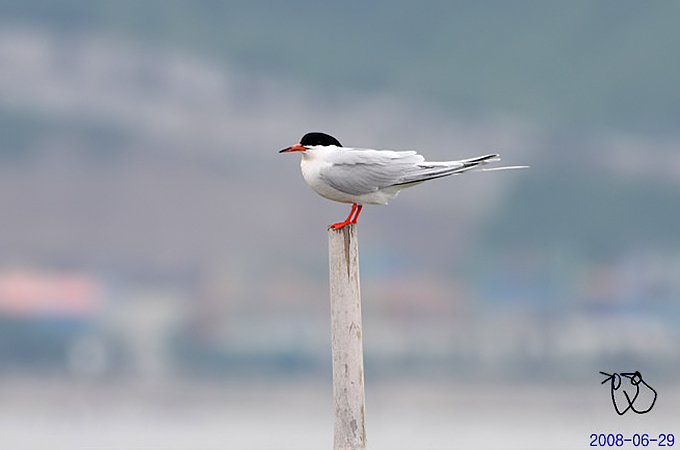
Common Tern Sterna hirundo longipennis P2 S.h.minussensis V1
Several minussensis, a subspecies not recorded annually in the ROK, were at the Nakdong Estuary, Busan, on June 29th (JSJ, KHE, KHY).
Little Tern Sterna albifrons S3, WV2 Br: 1
A locally common breeding summer visitor. There were at least 3000 at the Nakdong Estuary on July 9th (NM, JSJ) indicating a successful breeding season.
Whiskered Tern Chlidonias hybrida P5, WV1
First recorded in 1998, and reported with increasing frequency since. Fifty-one on Mara Island, on May 18th (JWRC) is the highest national count to date. The previous highest count was of thirty at Okgu Reservoir, Gunsan, on September 7th 2007.
Thick-billed Murre Uria lomvia V1/W5
First recorded in 2006, with a handful of subsequent sightings since, all along the east coast. In 2008, all records were from Gangwon Province: one was seen from Hwajin Po, on January 3rd (RN, HSN, PAN); one (presumed) sighting on February 17th at Daejin was followed by two more (probable) individuals on the 18th of that month (RN, HSN, PN, AN); one was at Okyge, on March 8th (NM); and one was seen at close range in breeding plumage off Daejin on March 9th (BH, JYK, KSH, NM, RN, SKS, TE).
Common Murre Uria aalge V1/W5
A seldom-reported winter visitor. One was seen off Hwajin Po, Gangwon Province, on January 3rd and 4th (RN, HSN, PAN), and at least two were offshore from there on January 23rd (NM, JF, SN, DT) and again on February 14th (AVF). Possibly up to seven were at nearby Daejin on February 18th (RN, HSN, PN, AN).
Spectacled Guillemot Cepphus carbo W5 Br: NN
Although thought possibly to breed locally in DPRK, it is a rare winter visitor to the ROK with the majority of records coming from near Hwajin Po in northernmost Gangwon Province. In 2008, two were off Hwajin Po on January 3rd (RN, HSN, PAN), with up to 17 counted in one scan a little south of there on January 23rd (NM, JF, SN, DT). Nine or ten were counted off Hwajin Po/Geojin on February14th (AVF) were followed by three at the same location on February 18th (RN, HSN, PN, AN). One was photographed at Yangyang, Gangwon Province, on March 1st (JJM), followed by one off Daejin on March 8th (NM). On March 9th, two were between Daejin and Geojin (BH, RN, NM).
Pigeon Guillemot Cepphus columba V2/Category 2
A probable, in breeding-plumage was seen (at medium-long range) from Daejin, Gangwon Province, on February 18th (RN, PN). This species is still listed on Category 2, due to lack of adequate documentation. There are three previous sight records (none with supporting details), the most recent in 2002.
Long-billed Murrelet Brachyramphus perdix  W5
W5
A scarce but increasingly recorded winter visitor, especially to the east coast. One was photographed on January 3rd and 4th off Hwajin Po, Gangwon Province (RN, HSN, PAN), and four were present between Hwajin Po and Yangyang on January 23rd (NM, JF, SN, DT). In February, seven were off Hwajin Po on the 14th - the highest national day count to date. Three were also seen there on February 15th (AVF). One was at Yangyang on February 16th and another at Daejin (both Gangwon Province) on the 18th (RN, HSN, PN, AN). One more was photographed at Guryongpo, Pohang, on February 18th (TE). In December, three were seen from Daejin on the 28th, with one again present on the 30th (RN).
Ancient Murrelet Synthliboramphus antiquus P/W1, S4 Br:1
A common winter visitor and local breeder. At Hwajin Po, Gangwon Province, very large numbers were seen moving south from various points on the coast on January 23rd, with between 100 and 250 birds/minute. This movement appeared to continue more or less uninterrupted for several hours, from 8AM until at least midday, so likely involved many (tens of) thousands of individuals (NM, JF, SN, DT).
(Japanese) Crested Murrelet Synthliboramphus wumizusume  V1 Br: 1/3
V1 Br: 1/3
Presumed to breed very locally in the far southwest, and also in the Dok Islands in the East Sea (Kwon & Yoo 2005). In 2008, one was seen off Mara Island, Jeju, on April 3rd (JWRC). Additionally one between Gunsan and Eocheong Island on April 1st (NM) mirrors a string of other possible sightings from the same area in 2007.
Least Auklet Aethia pusilla V2
A seldom-reported species in Korean waters. In 2008, three were seen on January 3rd, off Hwajin Po, Gangwon Province (RN, HSN, PAN), and one was present in the same area again on January 23rd (NM, JF, SN, DT). Two were again at Hwajin Po on February 14th (AVF), and one was also seen at Okgye, Gangwon Province, on March 8th (NM).
Hill Pigeon Columba rupestris R5 Br: 1
A rare and extremely localised resident in the ROK: considered to be more widespread in DPRK. At Hwaeum Temple, four were noted on February 18th (AVF), nine on May 7th (TE), and four again on October 21st (TNOR). Four were also reported from Cheoneun Temple (also in Jirisan National Park) on October 25th (RL, HW).
Red Turtle Dove Streptopelia tranquebarica V1
First recorded in the ROK in 1993 and seen annually or almost annually in recent years. In 2008, one female-type was photographed on Weiyeon Island, Chungcheongnam Province, between May 11th (KHG) and May 15th (PJH), and a male and female were photographed there on May 21st (YDH).
White-bellied Green Pigeon Treron sieboldii V1
One female photographed at Halla Arboretum, Jeju, on or around April 18th (KYH) is approximately the 15th record for the ROK.
Large Hawk-Cuckoo Hierococcyx sparverioides V2
First recorded in May 2007 on Socheong Island, Ongjin County. One heard only, also on Socheong Island, on May 12th (RN) is the second record of this distinctive-sounding species in Korea.
Ural Owl Strix uralensis R5 Br: 1
An apparently rare but increasingly recorded species, with breeding first confirmed in 2007. In 2008, one was photographed at Daejin, Gangwon Province, on February 17th (RN, HSN, PN, AN). A local resident (SJS) claims to have seen and heard this individual or another, at the same location, three or four times in February and March in recent years. In the southern part of Seorak Mountain National Park, near Yangyang (also Gangwon Province), one was photographed on May 31st (YDH), perhaps indicating local breeding. On December 26th another was photographed (MJH) at an undisclosed location.
Little Owl Athene noctua V1 Br: 1
Recorded annually in recent years, with most records falling in autumn and winter, and with one breeding record in 2007. In 2008, one was photographed at Chungju on February 4th (LHSA), with another photographed on October 20th in Gyeonggi Province (KCS).
Himalayan Swiftlet Collocalia brevirostris V1
A rare overshooting migrant, recorded near-annually since 2001, mostly in April or May. At least two, and possibly up to six, were seen at Eocheong Island on April 25th (GS, FVG). In Shinan County one was seen on April 27th (PJG) on Hong Island, while on Heuksan Island one was photographed on April 30th (PJG), with a different or perhaps the same individual photographed there on May 3rd (BSW) and again on May 8th (LKG).
House Swift Apus nipalensis V1
A rare migrant, recorded annually in recent years. In 2008 two were seen on May 17th, followed by one on May 24th, on Mara Island, Jeju (JWRC).
Grey-capped Pygmy Woodpecker Dendrocopos canicapillus R5 Br: 1
This species was considered formerly to be locally “not uncommon” as a summer visitor (Austin 1948) and subsequently as an uncommon resident (Gore & Won 1971), with few recent records until the 2000s. In 2008, a pair photographed at the nest-hole feeding young at Okcheon, Chungcheongbuk Province on June 8th (LYS) is apparently the first fully-documented breeding record in the ROK. Other records included two at Gwangneung Arboretum, Seoul, on January 18th (RN, PN, AN); two photographed at Ilsan, Seoul, on February 20th (MP); one at Daejeon on November 24th (BDB); and two at Samyook University, Seoul, on November 29th (RN).
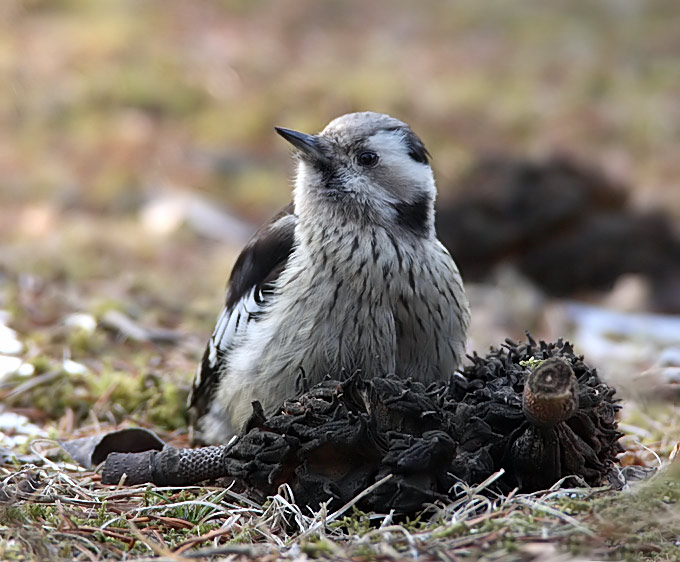
Brown Shrike Lanius cristatus P3 Br: 1
Although often reported in error in winter, one lucionensis/confusus Brown Shrike photographed at Seongsan Po, Jeju, on January 19th (JH, KCW, KEM) is believed to be the first adequately-documented mid-winter record for the ROK.
Long-tailed Shrike Lanius schach V1
Formerly considered to be a rare vagrant; now more likely to be resident in very small numbers (<5) in the southwest, with some continuing immigration or migration. Birds were reported in April, August and December on Hong Island, Shinan County (NPMBC 2008) and at Yongsu, Jeju Island, in December (Kang et al. 2010)
Black Drongo Dicrurus macrocercus P5
Away from the islands, where an uncommon migrant, one was photographed in Gojang County in Jeollabuk province on November 17th (LDJ).
Hair-crested drongo Dicrurus hottentotus V1
One banded on Hong Island, Shinan County, on November 16th (NPMBC 2008) is approximately the thirteenth national record.
Spotted Nutcracker Nucifraga caryocatactes R5 Br: 2
A rare and local resident, confined to the highest mountain peaks. In the ROK small populations have been reported from the Seorak and Jiri mountain ranges (in Gangwon and Jeollanam provinces respectively). On July 13th, five were photographed near the peak of Seorak Mountain (SKS). According to locals these are part of a group of 14 that are resident in this particular area, though more might also be present in a fenced-off area of forest nearby. This species has also been recorded from nearby Odae Mountain (SKS). In August, this species was also reported from Hwaak Mountain, Gangwon Province (via SKS).
Japanese Waxwing Bombycilla japonica  P/W4
P/W4
A scarce and irruptive winter visitor. Records in 2008 included seven at Gwangneung Arboretum on February 26th (KGH), at least 14 at Namhansan on March 28th (KDHY), and a flock of 40 at Misari/Paldang from February (LYS) until at least April 3rd (BDB) (all Seoul and environs). A flock of 30 was also in Busan on April 6th (LGS).
Yellow-bellied Tit Periparus venustulus V1
First recorded in October 2005. There were at least five records in 2008. The first was one photographed by PJG on February 22nd on Tokkeo Island, Jindo County, Jeollanam Province and the second was a breeding-plumaged male seen on Dokjeok Island, Gyeonggi Province (MP) on March 30th. In the second half of the year, a First-winter male was photographed on September 12th at Namhansan, Seoul, with the same or another photographed there on October 28th (IBH). On November 26th, one was seen near the International airport on Yeongjong Island (TA), and on December 15th one was photographed at Buan, Jeollabuk Province (via SKS), to become approximately the tenth national record.
Crested Lark Galerida cristata R5 Br: 1
One pair nested at Seosan in the spring, raising one young (SKS). There were no further sightings after April. Once considered to be abundant in the ROK (Gore & Won 1971), no other breeding sites have been confirmed in recent years.
Light-vented Bulbul Pycnonotus sinensis S5, RV2 Br:1
First recorded in 2002, with breeding first recorded on Socheong Island, Ongjin County (Moores 2007). One photographed at Suncheon City, Jeollanam Do on January 26th (JJM) is apparently only the second or third mainland record, and the first mid-winter mainland record. This was followed by one photographed on Gangwha Island, Incheon, on or around February 3rd (KGHO), the first record for this site. On March 30th, four were seen on Dokjeok Island, Gyeonggi Province (MP): the first record for this island. One was photographed at an undisclosed location in Ongjin-Gun, on April 19th (LSI). On Socheong Island, one was seen on April 22nd (PBW), with four or five present there on May 16th (NM, SH, JOH). Two on Baengnyeong Island, Ongjin County on May 10th (RN), and one on Seungbong Island, Incheon, on May 24th (TE) are both first records for those islands. This species has now been recorded from at least ten islands along the west coast (from north to south): Baengnyeong, Socheong, Ganghwa, Dokjeok, Seungbong, Beka, Eocheong, Hong, Heuksan, and Hatei Islands.
Eurasian Crag Martin Hirundo rupestris V2
First recorded in 2002, one seen on Socheong Island, Ongjin County on May 12th (RN) is approximately the 5th national record.
Common House Martin Delichon urbicum V1
First recorded in 2003, thereafter near-annually in April and early May, and again in September. During northward migration, two were seen on Eocheong Island, Gunsan, on April 23rd, with two again present there on the 26th (SSMP), and one was photographed on Mara Island, Jeju, on May 16th (JWRC). During southward migration, one was seen on September 26th on Socheong Island, Ongjin County (RN).
Korean Bush Warbler Cettia (Canturians) borealis P3, S4, WV2 Br: 1
A fairly common summer visitor to northern parts of the ROK and a more widespread migrant. One on Jeju Island on February 21st (AVF) and two at the same location on February 24th (BH) continue the run of mid-winter records since the first there in 2006.
Common Chiffchaff Phylloscopus collybita V2
First recorded in the DPRK in 2001 and in the ROK in 2004. In 2008, one photographed on Hong Island, Shinan County, on January 6th (HGP) is the second mid-winter record. One on Socheong Island on May 17th (NM) is the 7th record for the ROK.
Dusky Warbler Phylloscopus fuscatus P3, S4, WV1 Br: 1
One in Mokpo and one or two at Gocheonnam Lake, Haenam, on January 7th (NM) continues the trend of mid-winter records since the first in 2001. In December, one was again at Geocheonnam Lake, Haenam, on the 28th, with two seen there the next day (TBV).
Hume's Leaf Warbler Phylloscopus humei V1
First recorded in 2000, and annually in subsequent years. Field-identification, considered tentative by Moores (2007) is now supported by one or more banding records by the NPMBC. The species is apparently a scarce (and probably much overlooked) migrant, primarily in late April/early May and again in late October/early November. In 2008, one was on Eocheong Island, Gunsan, on November 7th and 8th (NM, MPO, MF, SA, IT, TG).
Lesser Whitethroat Sylvia curruca V2
One photographed at Gimpo, Seoul, on February 6th (JSS) remained until at least February 25th (PHS). This was followed by one photographed on Heuksan Island, Shinan County, on August 24th (PJG), becoming the first record outside of the winter months and the fifth record in total in the ROK.
Chinese Nuthatch Sitta villosa W5 Br:NN
A very scarce and apparently irruptive winter visitor, perhaps not recorded annually. One seen at Ilsan, Seoul, on March 15th (MP) was the only record in 2008 known to Birds Korea.
Eurasian Treecreeper Certhia familiaris R/W5 Br: 1
The winter of 2007/8 was remarkable for the large number of records of this species away from suspected breeding areas. The latest record from this influx was of one photographed in Guri, Seoul, on March 1st (YHS).
Red-billed Starling Spodiopsar sericeus P/W4, S5 Br: 1
In June and July approximately fifty pairs were observed nest-building in Gangseo-Gu, Busan (JSR), becoming the third ROK breeding record (Choi et al. 2011)
Common Starling Sturnus vulgaris W5
A scarce but increasing migrant and winter visitor. A flock of 40-50 on January 19th, at Daecheongdong, Jeju (JH, KCW, KEM) is perhaps the second largest flock known to Birds Korea, after a count of 100, also on Jeju Island, in December 2004.
Common Blackbird Turdus merula P5, RV1 Br: 1
First recorded in 1999 when found nesting. Now >20 records annually, mostly from offshore islands in spring. One male at Cheorwon on January 29th (JJE) is a rare winter and mainland record.
Black-throated Thrush Turdus atrogularis P/WV1
Records in 2008 include one or more on Hong Island in September and October (NPMBC 2008) and one at Heuksan Island (both Shinan County) on at least October 19th (TNOR), one at Hwaum Temple (Jiri Mountain) on October 21st (TNOR), and one First-winter at Gwangneung Arboretum, Seoul, on December 26th (KSOM).
Plumbeous Water Redstart Rhyacornis fuliginosus V2 Br:1
First recorded in 2006. In 2008, records involved six individuals from five separate locations. On Jeju Island, a male photographed on January 8th at Seogwipo (BIJ) remained until at least February 3rd (KHM). At the "South East river" in Gyeongsangnam Province, the pair resident since 2006 were still on territory on February 18th (AVF), with the male still present on November 5th (NM, MPO, MF, SA, IT, TG). At the "North East River" in Gangwon Province, a male was seen on January 22nd (NM, JF, SN, DT). At Odae Mountain National Park, Gangwon Province, a female was photographed on July 23rd (CBS). One male at a new site in Gyeongsangnam Province, present from at least October 3rd into November (RMF) appears to be the 9th record for the ROK.
Desert Wheatear Oenanthe deserti V2
A male, considered to be of the subspecies atrogularis, was photographed at Pohang, Gyeongsangbuk Province, on January 26th (MOE Census 2008), gaining some national media coverage. This is the first record of this species for the ROK, and it has been added to Category One of the Birds Korea Checklist.
Blue Rock Thrush Monticola solitarius S2, R4 Br:1
An intergrade male pandoo / philippensis (largely blue below, with very obvious reddish undertail coverts) was photographed on May 14th on Hong Island, Shinan County (JSS, LGS). Also of note, one philippensis banded on the same island on 17th September was later recovered on Taiwan (NPMBC 2008).
White-throated Rock Thrush Monticola gularis P4 Br:NN2
Following a rainstorm on May 18th, 100 were estimated to be present on Weiyeon Island, Chungcheongnam Province (SKS). This is the highest national day count to date. High counts of this species were recorded elsewhere during the same period, with e.g. 16 on Socheong Island, Ongjin County, on May 18th, and 21 in a separate area on May 19th (NM, SH, JOH). Fourteen were also on Eocheong Island, Gunsan, on May 18th and 19th (AB, CH).
Blue-and-White Flycatcher Cyanoptila cyanomelana cumatilis V2/1
A male of the scarcely-reported cumatilis subspecies was seen on Eocheong Island, Gunsan, on April 24th (SSMP).
Eastern Yellow Wagtail Motacilla tschutschensis tschutschensis P2 M. t. taivana P3, W5
Three, including one First-winter taivana, were photographed on February 20th on Jeju Island (AVF): this is only the second national record of overwintering known to Birds Korea. This was followed by two more in a separate area on Jeju Island on February 21st (AVF). One at Geocheonnam, Haenam, on January 7th (NM, KSK) is apparently the first record of overwintering away from Jeju Island. It was followed by two taivana at Goheung Bay, Jeollanam Province, and one at Geocheonnam, Haenam on December 28th and 29th, and one taivana at Haenam Hwangsan on December 29th (TBV).
Citrine Wagtail Motacilla citreola P5
A scarce annual migrant to offshore islands, most often recorded in April and May. Three on Heuksan Island on May 3rd (AA) is the highest day count known to date. A male photographed at Songchheon Ri, Namyangju, Gyeonggi Province on May 16th (LWG) is apparently only the third mainland record for the ROK known to Birds Korea.
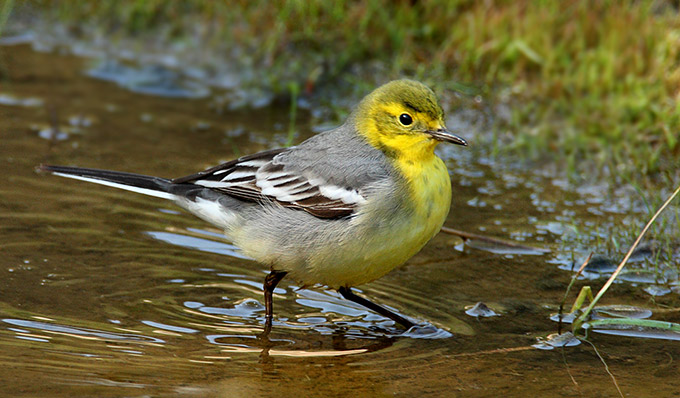
White Wagtail Motacilla alba lugens P/W3 Br:NN M.a.baicalensis V1
In 2008 there were at least five records of the seldom-reported baicalensis subspecies. One was photographed on Heuksan Island on March 28th (PJG); the same or another was on Heuksan Island in April (NPMBC 2008); one was on Jeju island in April (Kang et al. 2010); and there was also one on Eocheong Island, Gunsan, on April 21st (SSMP), with two at the latter site on April 23rd (SSMP).
Richards Pipit Anthus richardi P3, WV2
A widespread but rather uncommon migrant. One at Seongsan Po, Jeju Island, on February 21st (AVF) is perhaps the first winter record for the ROK. Twenty-four at Song Do, Incheon, on September 21st (TE) is a notably high mainland count.
Tree Pipit Anthus trivialis V1
Rare, but recorded annually in recent years after the first records in 2000. One was photographed on May 1st on Heuksan Island (AA), with the same or another also present there in May (NPMBC 2008); and one was photographed on May 18th on Weiyeon Island (SKS).
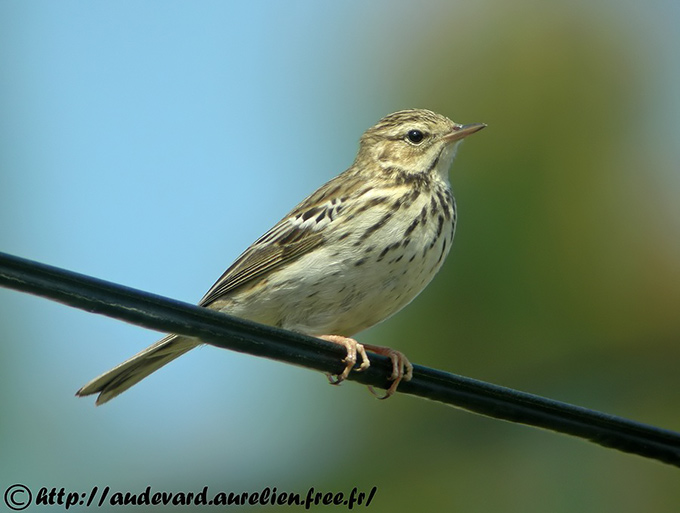
Pechora Pipit Anthus gustavi P3
One seen on April 22nd, on Eocheong Island, Gunsan, (SSMP) is an atypically early date.
Rosy Pipit Anthus roseatus V2
One photographed on Mara Island, Jeju, on June 7th (JWRC, KYH) is apparently only the 7th national record, and the first record outside of the migration periods.
Buff-bellied Pipit Anthus rubescens P/W2
One, perhaps of the nominate subspecies was photographed on February 19th at Misari, Seoul (PHS). A flock of 260 at Simpo, Saemangeum, on December 31st (TBV) is largest single concentration known to Birds Korea.
Water Pipit Anthus spinoletta V1
One was photographed at Seosan on January 31st (KJC), with another at Anyang stream between February 13th and 16th (SKS). Three recorded on Mara Island, Jeju, on April 11th (JWRC) is believed to be the highest national day count, and only the third April record.
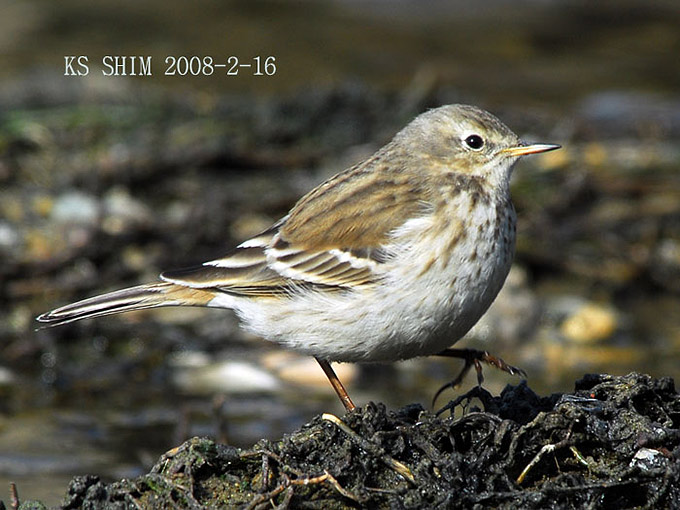
Common Redpoll Carduelis flammea V1
Described as a “common but irregular visitor” by Gore & Won (1971), there have been very few records in recent years. One photographed at Seosan on February 10th (LKG) is perhaps the first fully-documented record this century in the ROK. This was followed by a second record at Olympic Park, Seoul on March 1st, and a third on May 7th on Weiyeon Island, Chungcheongnam Province (via SKS).
Asian Rosy Finch Leucosticte arctoa V2
A flock of up to 20 was reported from the summit of Geumjeong Mountain, Busan from approximately December 23rd (via SKS) into January 2009. This is apparently the first flock to have been seen by a large number of observers in the ROK. There are fewer than ten previous records in the southern provinces, with exceptional numbers last seen in 1998, when according to Park (2002) there was one on Dobong Mountain, six on Bukhan Mountain (both in Seoul) and 300 in Taebaek City, Gangwon Province.
Japanese Grosbeak Eophona personata P/W5
The two largest concentrations recorded during the year were 21 were at Mount Halla Arboretum, Jeju Island on February 20th (AVF, and subsequently seen by many observers throughout the month), and 25 at Gwangneung Arboretum, Seoul, from December 23rd (via SKS).
Pine Bunting Emberiza leucocephalos P/W5
A male photographed on Eocheong Island, Gunsan, on April 2nd and 3rd (NM) appears to be of the subspecies fronto (as was a male on the same island on March 25th 2003). Most records of this scarce species in the ROK are assumed to be of the nominate subspecies.
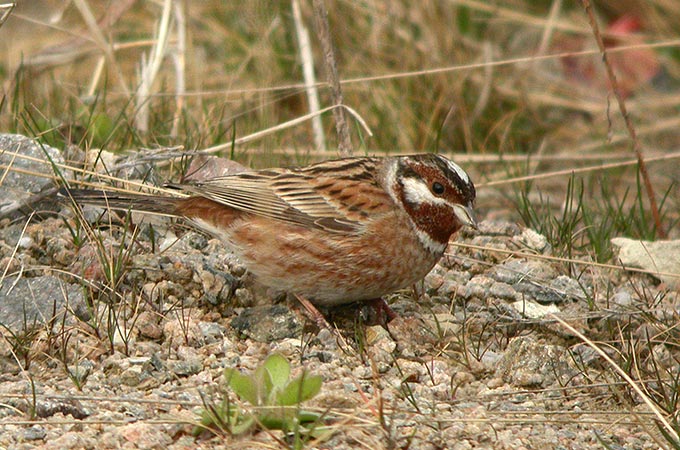
Ortolan Bunting Emberiza hortulana V2
A male photographed on Weiyeon Island, Chungcheongnam Province on May 25th (YDH) is the first record supported by photographs in the ROK, and this species has therefore been moved to Category One of the Birds Korea Checklist. There are two earlier sight records, both on Gageo Island, Shinan County, in 2000: an adult male on May 2nd (NM) and an adult female or First-winter male on November 9th (NM & Mokpo MBC TV documentary crew).
Tristram's Bunting Emberiza tristrami P2, S3, W5 Br:1
One at Hwaeum Temple near Gurye on February 18th (AVF) is perhaps only the eighth midwinter record, but continues the trend of mid-winter records in the southern provinces.
Black-headed Bunting Emberiza melanocephala V2
A male photographed on Weiyeon Island, Chungcheongnam Province, on April 27th (LYM) is apparently the 9th record for the ROK, and only the third away from Eocheong Island.
Japanese Yellow Bunting Emberiza sulphurata VU P4
A scarce migrant through southern and western islands. Twenty recorded between April 22nd and April 24th (AA) on Heuksan Island, Shinan County, is a notably high count.
Grey Bunting Emberiza variabilis P/W4
One at Halla Arboretum, Jeju, on February 20th (AVF) is the only record in 2008 known to Birds Korea.
Common Reed Bunting Emberiza schoeniclus P/W2
An adult male, assuming breeding plumage, photographed at Incheon on June 1st (BDB) is exceptionally late.
Lapland Longspur Calcarius lapponicus W2
A locally abundant winter visitor which appears to be largely restricted to a handful of traditional wintering sites along the west coast. A flock of 900 at Seosan on January 6th (NM, KSK, KHT) is a typical count for that site. In November, 50 were seen on the far southwestern Mara Island, Jeju - a first record for that island.
Snow Bunting V1
One was photographed at Jumunjin, Gangwon Province on November 30th (HJH).
Also for the Record…
There were records of four notable species that lacked adequate observation or documentation. These will be stored in a “pending file” for consideration at a later time.
Bar-headed Goose Anser indicus V2
One probable immature was seen briefly and incompletely in amongst a large flock of grey geese at Seosan on November 2nd (RN). No images were taken and the bird could not be relocated. There is only one fully-documented record (in 2003).
Albatross sp.
During the summer, an “albatross” was apparently seen multiple times by fishermen far offshore from Sokcho, Gangwon Province. However, there are no images and no proper description was provided.Lesser Kestrel Falco naumanni  V2
V2
One seen amongst a group of Amur Falcon Falco amurensis at Paju on September 1st by an observer with prior experience of the species (KHK) is probably the second national record (after the first on Gageo Island in November 2001).
Stilt Sandpiper Calidris himantopus
One probable post-breeding plumaged bird was watched at fairly long range wading in belly-deep water in the Seosan Reclamation Area on September 18th. It was flushed with all other shorebirds present by a raptor and could not be relocated (NM, BB).References
- Austin, O. L., Jr 1948. The birds of Korea. Bulletin of the Museum of Comparative Zoology, Harvard University 101: 1-301.
- BirdLife International. 2011. IUCN Red List for birds. Downloaded on multiple dates in January 2011.
- Birds Korea. 2010. The Birds Korea Blueprint 2010 for the conservation of the avian biodiversity of the South Korean part of the Yellow Sea. Published by Birds Korea, October 2010.
- Brazil, M. 1991. The Birds of Japan. Published by Helm.
- Choi C-Y., Park J-G., Moores, N., Kim E-M., Kang C-W., Nam H-Y. & Kim S-M. 2011. The recent increase of the Red-billed Starling Sturnus sericeus. Forktail 27: 84-86.in the Republic of Korea.
- Duckworth, J. W. & N. Moores. 2008. A re-evaluation of the pre-1948 Korean breeding avifauna: correcting a ‘founder-effect’ in perceptions. Forktail 24: 25-27.
- EAAF. 2011. Color Markings Used in the East Asian-Australasian Flyway, downloaded in December 2011 at: http://www.eaaflyway.net/documents/wg/eaaf_anatidae_colormarkings_v2.pdf
- Earnst, S. 2004. Status assessment and conservation plan for the Yellow-billed Loon (Gavia adamsii). Denver, U.S.A. U.S Geological Survey.
- Edelsten, T. & N. Moores. 2008. The Birds Korea Bird Review 2007. Online at: http://www.birdskorea.org/Birds/Birdnews/BK-BN-Review-2007.shtml.
- Gore, M. & Won P-O. 1971. The Birds of Korea. Published by the Royal Asiatic Society.
- Kang C-H., Kang H-M., Kim E-M., Park J-G. & Ji N-J. 2010. Birds of Jeju. Wild Bird Field Guide. Doseocheulpan Hanguru. (In Korean).
- Kwon Y-S. 2009. Effects and Conservation of Seabirds by Invasive Species in South Korea. In Chae H-Y., Choi Y-C., & Nam H-Y. (eds). 2009. Seabirds in danger: invasive species and conservation of island ecosystem. Proceeding of the 3rd International Symposium on Migratory Birds. Publication of the National Park Migratory Birds Center, Shinan, Korea, 153p.
- Kwon, Y-Soo & Yoo, J-C. 2005 Breeding Record of the Crested Murrelet (Synthliboramphus wumizusume) at Dokdo Island. Korean Journal of Ornithology 12(2): 83-86. (In Korean with English Abstract.)
- Lee H-S., Lee S-W., Lee K-S. & Paek W-K. 2004. The wintering status of Cinereous Vultures (Aegypius monachus) in Korea. p. 237 in Rhim S-J., Kim J-S., Chung O-K. & Park S-J. (Eds.) Proc. 2004 Intern. Symp. Migratory Birds, Gunsan. Orn. Soc. Korea, Seoul.
- MOE Census. 2008. Ministry of Environment Winter Bird Census (in Korean).
- Moores, N. 1999. A Survey of the Distribution and Abundance of Shorebirds in South Korea during 1998-1999: Interim Summary. Stilt 34: 18-29.
- Moores, N. 2002. Wetlands: Korea’s most-threatened habitat. OBC Bull. Number 36: 54-60.
- Moores, N. 2006. South Korea’s Shorebirds: A Review of Abundance, Distribution, Threats and Conservation Status. Stilt 50: 62-72. Published by the Australasian Wader Studies Group.
- Moores, N. 2007. Selected Records from Socheong Island, South Korea. Forktail 23: 102-124.
- Moores, N. 2012. The Distribution, Abundance and Conservation of the Avian Biodiversity of Yellow Sea habitats in the Republic of Korea. Doctoral thesis, University of Newcastle, Australia.
- Moores, N., Park J-G. 2009. The Birds Korea Checklist: 2009. Published online in August 2009 and accessed in November 2011 at: http://www.birdskorea.org/Birds/Checklist/BK-CL-Checklist-Aug-2009.shtml
- Moores, N., Rogers, D., Kim R-H, Hassel, C., Gosbell, K., Kim S-A & Park M-N. 2008. The 2006-2008 Saemangeum Shorebird Monitoring Program Report. Birds Korea publication.
- Park, J-Y. 2002. Current status and distribution of birds in Korea. Department of Biology, Kyung Hee University, Seoul (unpublished thesis, in Korean).
- Wetlands International. 2006. Waterbird Population Estimates - Fourth Edition. Wetlands International, Wageningen, The Netherlands.
- WWT. 2011. Wildfowl and Wetlands Trust. Online account on Scaly-sided Merganser, downloaded December 2011 at: http://www.wwt.org.uk/what-we-do/saving-wildlife/science-and-action/globally-threatened-species/scalysided-merganser
- Zöckler, C. & G. Bunting. 2010. The Spoon-billed Sandpiper: a Flyway-wide Perspective. in Birds Korea 2010.





